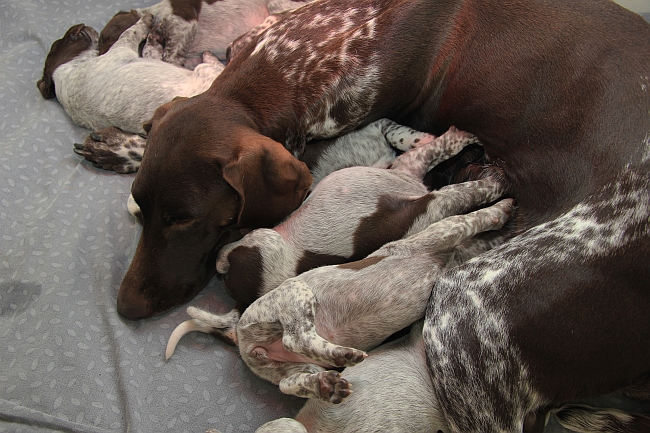Dog pregnancies can be a great experience for the entire family. Young children can experience the entire pregnancy cycle, and even watch the puppies being born. And the adults can share this experience with their children. Even those without children can grow with this experience, as going through trials and difficulties of the pregnancy with the dog, can bring them closer to their beloved pet, and bring beautiful new puppies into the household. But how long are dog pregnancies?
Unlike humans, dogs have a much shorter gestation period which is usually between 58 to 67 days (about two months). There are a variety of factors that can impact the gestation period:
Size of the Breed: Smaller dog breeds will have a gestation period for a longer period (close to the longer end of the range mentioned above). It is also interesting to note that it is the size of the mother is what dictates the length of the pregnancy, so a cross between two breeds with a small mother will have a longer gestation period than a cross with a larger sized maternal breed.
Size of the Litter: Depending how large the litter of pups is; the gestation period will vary. Smaller litters will have more room to grow in the uterus, so the pregnancy will last longer with a smaller litter. The smaller the litter the longer the pregnancy.
Familial History: Not many people have access to such information, but the average length of pregnancy in a dog’s ancestors can be indicative of the length of pregnancy a dog will have.
What Happens During Each Week of Pregnancy?
When a female dog begins ovulating (is in heat), she will accept a male, but not before. Once mating has taken place, the sperm will take several days to reach its destination and for fertilization to occur.
During the second week of pregnancy, the fertilized eggs will start moving down the uterine tract as they begin to grow and develop into tiny embryos. Their initial destination is the uterine horns where they will rest in the uterine fluid before they begin attaching themselves to the uterine walls. At less than 10 millimeters long, the embryos create a connection with the uterine wall in order to have access to the supply of nutrients they need for growth.
During the fourth week the embryos develop the facial features, as well as eyes, ears and spine. This tiny creature is still only around 15 millimeters long. It is at this point that a veterinarian can definitively say whether a dog is pregnant.
By the fifth week the embryos have grown to become dog fetuses, and the growth rate will increase which means that the mother will need more energy (food) to help support her growing fetuses. The veterinarian will also be able to perform an ultrasound test to let you know how many puppies to expect.
Week six is when the mother will definitely look like she is pregnant, and during the seventh week she will begin to lose the hair on her stomach in preparation for the delivery. At the same time, the puppies begin growing hair in preparation for being born.
During the eighth week the mother-to-be will begin nesting (deciding where she will give birth, and preparing the area for her puppies). Her body will also begin to produce milk.
The puppies are coming! The ninth week is when you can expect the puppies, and they can come either at the beginning or the end of the ninth week.

